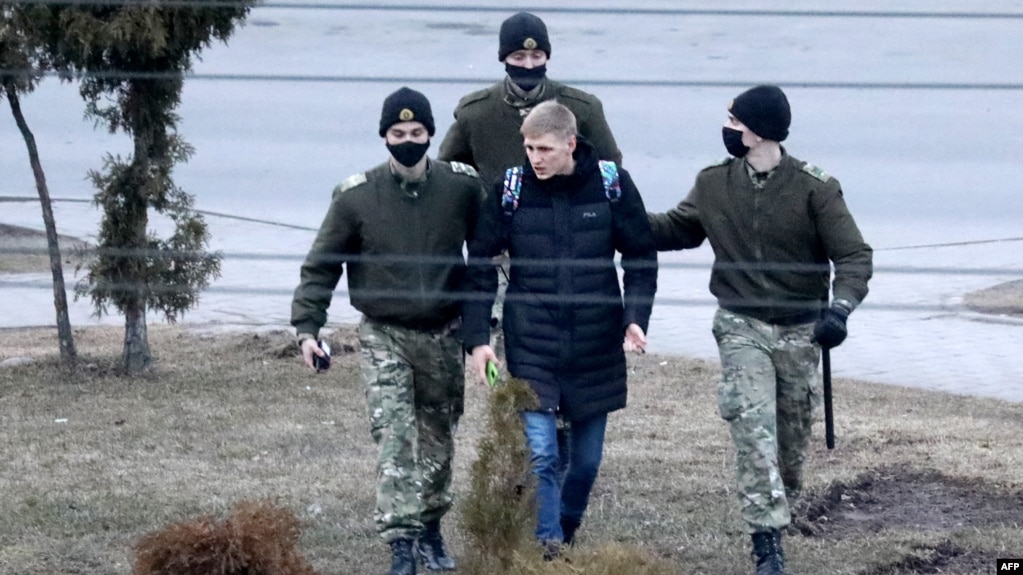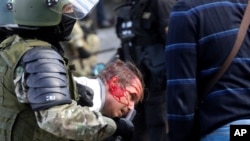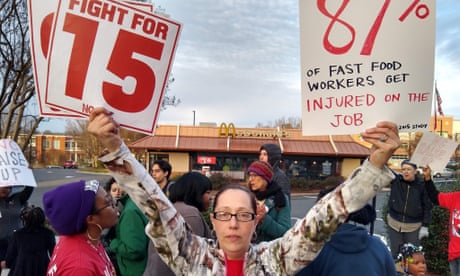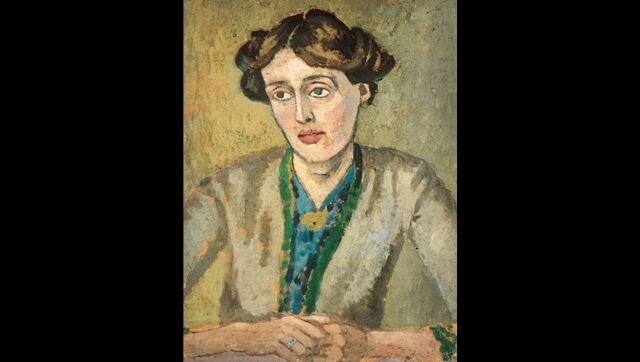Freedom Day March Highlights Challenges Facing Belarusian Opposition
By Tony Wesolowsky
March 26, 2021

As pro-democracy supporters marched down the streets of Minsk on March 25, a reporter did a video interview with Nina Bahinskaya, a frail yet fiery veteran of protests in Belarus for decades.
As Bahinskaya speaks while she walks, a chilling scene plays out a few meters behind her. A woman -- later identified as film student Maria Tsikhanava -- is quickly approached by what appears to be a black-clad, balaclava-wearing Belarusian security officer, who grabs her and whisks her away, all in a few seconds and all unbeknownst to Bahinskaya, who marches on.
Belarusian leader Svyatlana Tsikhanouskaya had hoped the rally on March 25 -- or Freedom Day, as it is also the day commemorating the founding of a short-lived democratic Belarusian republic more than 100 years ago -- would breathe new life into the country's protest movement demanding Alyaksandr Lukashenka, in power since 1994, step down.
The country has been rocked by protests since Lukashenka claimed a landslide victory and a sixth straight term in an August presidential election that many Belarusians believe was rigged in his favor. Supporters of Tsikhanouskaya, a political novice who was buoyed by big crowds at campaign rallies, was the actual winner. She is now in exile in neighboring Lithuania.
Tens of thousands marched in the wake of the disputed vote, but those numbers have dwindled in the last few months. Winter weather and weariness have contributed, but the incident filmed on the streets of Minsk on March 25 highlights the huge risk Belarusians take in coming out to voice opposition to Lukashenka.
More than 33,000 have been detained, hundreds beaten on the streets or in detention, some described by rights groups as torture, at least four people have been killed, and independent reporters targeted in the government crackdown. "The Belarusian authorities are conducting a targeted campaign of intimidation against civil society in an effort to silence all critics of the government," Human Rights Watch said on March 18 in a statement.
Anatomy Of A Cover-Up? Why Belarus's Denials In Death Of Protester Don't Ring True
Crushing Protests
Ahead of the planned action, the commander of Interior Ministry troops, Mikalay Karpyankou, described Belarusian protesters as "enemies of our state," before vowing to "deal with them quickly," and harshly as in the past "with pleasure."
Crisis In Belarus
Read our coverage as Belarusians continue to demand the resignation of Alyaksandr Lukashenka amid a brutal crackdown on protesters. The West refuses to recognize him as the country's legitimate leader after an August 9 election considered fraudulent.
Ivan Tertel, the head of the KGB, told Lukashenka on March 9 that foreign actors were applying "unprecedented pressure on our state," claiming -- without providing evidence -- that plans had been discovered to "destabilize the situation" in Belarus on March 25-27.
State-run TV had aired footage of Interior Ministry forces drilling ahead of the planned demonstrations. On March 25, police and army officers, police vans, military vehicles, were out in force across Minsk in a not so subtle hint to the public to stay away.
Lukashenka's government has justified its actions by casting protesters as pawns of foreign forces and being bent on causing havoc.
To avoid being swept up in any mass police crackdown, the Nexta Telegram channel, which has mobilized and coordinated demonstrations, had urged protesters to march through courtyards and organize flash mobs.
Even with less-concentrated crowds, the Belarusian human rights monitor Vyasna said a total of 245 people were detained in 23 cities and towns across Belarus on March 25, including 176 in Minsk.
Franak Viacorka, an adviser to Tsikhanouskaya, said there had been "hundreds of actions," including fireworks, flash mobs, performances, and courtyard rallies, but acknowledged the "tanks and armored vehicles" deployed by Lukashenka, had "frightened" people along with the earlier repressions and beatings. "It is clear this all had an impact on the number of people [who turned out on March 25]," Viacorka told Current Time, the Russian-language network led by RFE/RL in cooperation with VOA.
Growing International Pressure
While Lukashenka may for now "control the streets," as Tsikhanouskaya herself acknowledged in February, he is losing what leverage he had left on the international stage, at least in the West.
The UN's top human rights body on March 24 voted to investigate allegations of widespread human rights abuses in Belarus. Russia, which has close ties to Belarus and has helped prop up Lukashenka since the disputed election, was one of the countries to vote against the measure.
UN human rights chief Michelle Bachelet has been asked to lead the investigation aiming to bring alleged perpetrators to justice. The rights council authorized a budget of $2.5 million and the hiring of 20 experts and staff to carry out the investigation.

SEE ALSO:
Is China Cooling On Belarus's Lukashenka?
Washington, subdued in its criticism under former President Donald Trump, has become more vocal under President Joe Biden. On March 25, the U.S. State Department demanded the immediate release of the more than 290 political prisoners in Belarus, and highlighted the plight of Ihar Losik and Maryya Kalesnikava.
Kalesnikava, who faces national-security charges that supporters say are absurd, had her pretrial detention extended on March 22. Arrested in September, Kalesnikava, a key aide to Tsikhanouskaya and a senior member of the opposition's Coordination Council, was ordered to remain in detention until May 8.
Losik, a popular blogger and RFE/RL consultant, has been held since June on charges his supporters say are trumped up. He had been charged initially with allegedly using his popular Telegram channel to "prepare to disrupt public order" ahead of the August 9 presidential election.
Losik, 28, tried to slit his wrists and launched a four-day hunger strike on March 11 after being informed he faced new unspecified charges.
The statement by State Department spokesman Ned Price came a day after the top two members of the U.S. House Foreign Affairs Committee also called for the release of all political prisoners in Belarus and pledged their support for the pro-democracy movement in the country. "We will continue to support the Belarusian people's democratic aspirations until the illegitimate Lukashenka steps down, all political prisoners -- including RFE/RL consultant Ihar Losik -- are released and, new free and fair elections are held," Representatives Gregory Meeks (Democrat-New York) and Representative Michael McCaul (Republican-Texas) said in a statement.
The European Union, United States, Canada, and other countries have refused to recognize the 66-year-old as the legitimate leader of Belarus and have slapped him and senior Belarusian officials with sanctions in response to the "falsification" of the vote and postelection crackdown.
Angry Neighbors
On March 25, Estonia, Latvia, and Lithuania imposed travel bans on another 118 Belarusian officials. The first round of bans since November expands the list of the sanctioned, already containing Lukashenka, to a total of 274, the Lithuanian Foreign Ministry said.
Lukashenka also faces worsening relations with Poland, which accuses Belarus of persecuting the ethnic Polish community.
Andrzej Poczobut, a journalist and a member of the Association of Poles in Belarus was detained in Hrodna early on March 25, two days after the association's leader, Andzelika Borys, was arrested and sentenced to 15 days in jail. The arrest came amid a worsening standoff following tit-for-tat diplomatic expulsions this month, including the heads of the Polish consulates in Brest and Hrodna.
And while Belarusians may be for now reluctant to return to the street, more than 750,000 have added their signature to an online campaign launched by Tsikhanouskaya to demand Lukashenka enter internationally mediated talks on ending the political crisis.
Nexta has called for mass protests on March 27, casting it as "the day we start the second wave of street protests."
Despite the fear instilled by the Lukashenka government crackdown, Viacorka is convinced it is only a matter of time before Belarusians turn out in larger numbers.
"People need to be shoulder to shoulder with one another, to see again that they are the majority, to feel that energy they got from those large marches," he said.
With reporting by Current Time and RFE/RL's Belarus Service

Tony Wesolowsky is a senior correspondent for RFE/RL in Prague, covering Belarus, Ukraine, Russia, and Central Europe, as well as energy issues. His work has also appeared in The Philadelphia Inquirer, the Christian Science Monitor, and the Bulletin Of The Atomic Scientists.




















